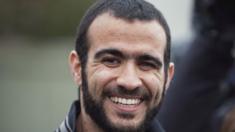
The US has confirmed that North Korea has tested a long-range missile which experts believe could reach Alaska.
Secretary of State Rex Tillerson called it a "new escalation of the threat" to the US and the world and warned that Washington "will never accept a nuclear-armed North Korea".
Pyongyang claimed on Tuesday to have successfully tested an intercontinental ballistic missile (ICBM).
In response the US and South Korea fired missiles in the South's waters.
The combined military exercise was designed to show their "precision fire capability", the Pentagon said.
Though Tuesday's test appeared to be a significant development, experts believe that North Korea does not yet have long-range nuclear weapon capabilities.
- Is the new missile test a game-changer?
- Can the US defend itself against North Korea?
- Have North Korea's missile tests paid off?
- What can the outside world do?
Mr Tillerson also warned that any nation that provided economic or military benefits to the North or failed to fully implement UN Security Council resolution was "aiding and abetting a dangerous regime".
The US has asked for an urgent meeting of the UN Security Council to discuss the issue. A closed-door session of the 15-member body is expected later on Wednesday.
What did North Korea say on Tuesday?
The announcement on North Korea state television said the Hwasong-14 intercontinental ballistic missile (ICBM) test was overseen by leader Kim Jong-un.
It said the projectile had reached an altitude of 2,802km (1,731 miles) and flew 933km for 39 minutes before hitting a target in the sea.

North Korea, it said, was now "a full-fledged nuclear power that has been possessed of the most powerful inter-continental ballistic rocket capable of hitting any part of the world".
North Korea's official KCNA news agency later quoted Kim Jong-un as saying the test was a "gift" to the Americans on their independence day.
The launch, the latest in a series of tests, was in defiance of a ban by the UN Security Council.
But experts believe Pyongyang does not yet have the capability to miniaturise a nuclear warhead that can fit onto a long-range missile, and that such missiles cannot accurately hit targets.

How far could this missile travel?
The big question is what range it has, says the BBC's Steven Evans in Seoul. Could it hit the United States?
David Wright, a physicist with the US-based Union of Concerned Scientists, says that if the reports are correct, this missile could "reach a maximum range of roughly 6,700km on a standard trajectory".
That range would allow it to reach Alaska, but not the large islands of Hawaii or the other 48 US states, he says.
It is not just a missile that North Korea would need, our correspondent adds.
It must also have the ability to protect a warhead as it re-enters the atmosphere, and it is not clear if North Korea can do that.



What does this test tell us? By defence expert Melissa Hanham
Once again North Korea has defied the odds and thumbed its nose at the world in a single missile launch. With the test of the Hwasong-14, it has shown that it can likely reach intercontinental ballistic missile ranges, including putting Alaska at risk.
Kim Jong-un has long expressed his desire for such a test, and to have it on the 4 July holiday in the US is just the icing on his very large cake.
 REUTERS
REUTERS
Despite this technical achievement, however, it is likely many outside North Korea will continue to be sceptical. They will ask for proof of working guidance, re-entry vehicle, and even a nuclear warhead.
From a technical perspective, though, their engines have demonstrated ICBM ranges, and this would be the first of several paths North Korea has to an ICBM with even greater range.

What is an ICBM?
- A long-range missile usually designed to carry a nuclear warhead
- The minimum range is 5,500km (3,400 miles), although most fly about 10,000km or more
- Pyongyang has previously displayed two types of ICBMs: the KN-08, with a range of 11,500km, and the KN-14, with a range of 10,000km, but before 4 July had not claimed to have flight tested an ICBM. It is not clear what differentiates the Hwasong-14

Are neighbours and nuclear powers concerned?
South Korea's President Moon Jae-in has called on the United Nations Security Council to take steps against North Korea.
A strong warning came from the South's director of operations of the Joint Chiefs of Staff. Cho Han-Gya said "Kim Jong Un's regime will face destruction" if it "ignores our military's warnings and continues provocations".
Japan said "repeated provocations like this are absolutely unacceptable" and Prime Minister Shinzo Abe said his country would "unite strongly" with the US and South Korea to put pressure on Pyongyang.
 KCNA/REUTERS
KCNA/REUTERS
Meanwhile China - who is Pyongyang's main economic ally - and Russia have called on North Korea to suspend its ballistic missile programme in exchange for a halt on the large-scale military exercises by the US and South Korea.
Chinese President Xi Jinping and Russian counterpart Vladimir Putin, who met in Moscow on Tuesday, said "the opposing sides should start negotiations".
US President Donald Trump has repeatedly called on China to pressure North Korea to end its nuclear and missile programmes.
On the prospect of North Korea being able to strike the US, he tweeted in January: "It won't happen." However experts say it might - within five years or less.
UK Foreign Secretary Boris Johnson also called on the international community to "redouble its efforts to impose a price on this regime, which strains every nerve and sinew to build nuclear weapons and launch illegal missiles, even as the people of North Korea endure starvation and poverty".


No comments:
Post a Comment